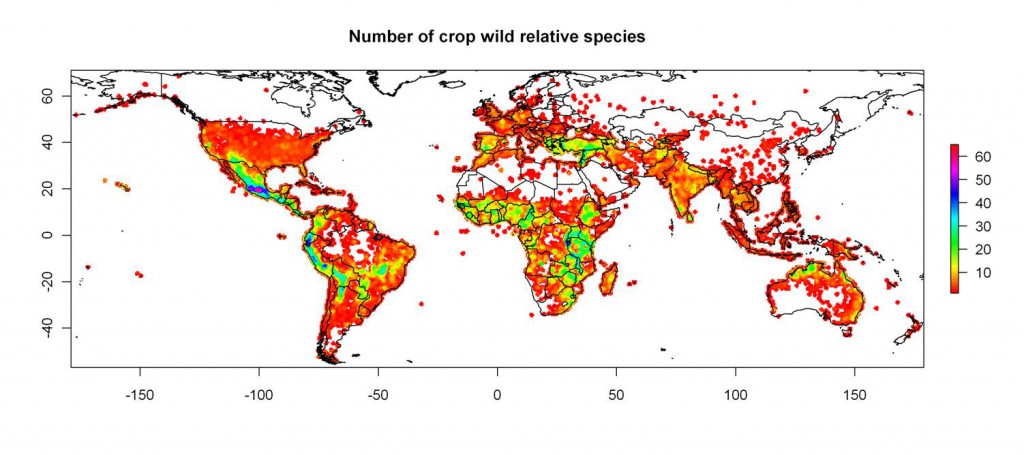- ILRI slideshow on adapting South Asian livestock systems to climate change. And some background.
- Latest on Nepal’s new genebank.
- Salicornia 101.
- GENERA: a database of published, peer-reviewed scientific papers that are related to the risks and safety of genetic engineering in agriculture. Courtesy of Biofortified.
Did wild relatives get a boost at Nagoya?
I think I may have Nibbled the fact that IUCN released a few days ago at Nagoya the results of a massive study of the global pattern of threat to vertebrate diversity. Here’s the money map:
Also to coincide with Nagoya, IUCN collaborated with Kew and the Natural History Museum, London on a global analysis of extinction risk for the world’s plants.
And of course, the A-Z Guide of Areas of Biodiversity Importance was launched at a side event at COP 10. The press release is on the UNEP website.
Compare and contrast with this map Julian Ramirez of CIAT has kindly sent me, showing the richness of wild relatives of a dozen or more major crops. Question for anyone who was at Nagoya: were livestock and crop wild relatives discussed during the proceedings?
I ask because in a recent posting on the Crop Wild Relatives discussion group, Nigel Maxted suggests that launching an initiative to “(establish) … a Global Network of CWR Protected Areas is now a real priority, along with systematic ex situ conservation!”
So what happened?
Nibbles: Ethiopia, India, Japan, Netherlands
- Ethiopia rehabilitating more than 100 wheats and barleys in anticipation of climate change.
- MS Swaminathan Research Foundation makes images available.
- Minor delays on the road to Nagoya Protocol and CBD COP 12 in India.
- Placing ecosystems thinking at the heart of global food security. ILRI prepares for climate gabfest in The Hague.
Nibbles: Ethics, Seeds, Coconut, Nordic genebank
- Ethical Considerations in Agro-biodiversity Research, Collecting, and Use. In case you were thinking of doing some.
- Seed control ceded?
- “Scores of women from the rural households brought in finest homemade recipes on coconut.” My kind of conference.
- “Unique plant bank threatened,” says Google Translate of Nordic genebanks. Thanks Britta.
Old and new Nordic spring wheats side by side
Pictures being worth a thousand words, and all that, here are pictures — moving pictures, no less — of some Swedish wheats that were planted out for regeneration and characterization earlier in 2010.
Thanks Dag for the link. How hard would it be to make links to this sort of thing available from all-knowing databases, I wonder? Dag thanks the film-maker, Axel Diederichsen, for putting the names of the varieties into his description of the film, and suggests adding the accession numbers. If everyone did that, some kind of spider could surely crawl the web looking for, and linking to, any and all mentions of the number, and linking to them. With human curation, of course.
Is that crazy?

